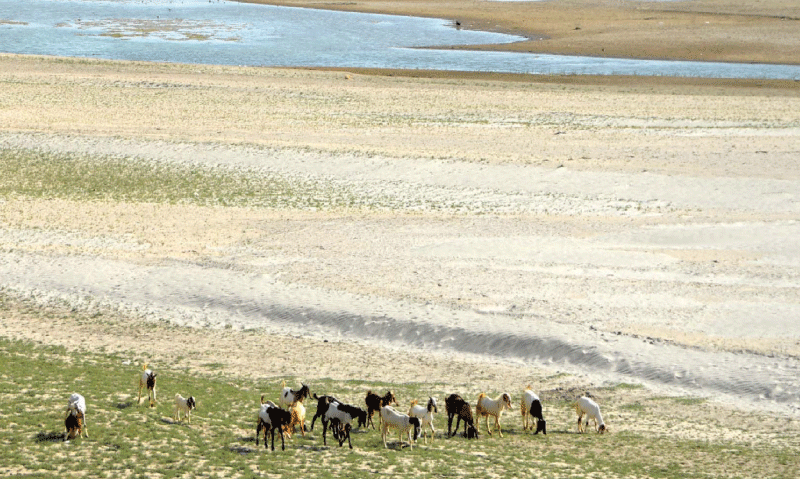
ON March 27, a report in this newspaper quoted an unnamed official of the irrigation bureaucracy as saying: “There is no water in dams, river flows have plunged and fewer snow deposits on mountains are not promising improved inflows.” The same irrigation bureaucracy has been tasked to front a new wave of canal-building that will ostensibly give rise to a (corporate) agricultural revolution.
Pakistani officialdom loves its contradictions, but this one is of another magnitude altogether. Our wise planners will argue that just as this year the water shortage is due to fewer winter rains/ snowfall, the situation may be reversed next year. But any objective analysis of water flows over the past few years confirms that aridity is increasing.
While in years gone by water shortages became apparent in the early summer months (May/June), the alarm bells are now ringing in March. And the creeping crisis is not limited to irrigation water for agriculture. Sindh’s coastal delta regions are now dilapidated shadows of their former selves, entire ecologies and cultures heading towards extinction.
It is true that the overall decrease in water flows is partially offset by extraordinary rains, as we saw in the 2022 monsoon. But all scientific projections worth their salt confirm the long-term trends: by one estimate, 62 million hectares (153m acres) of the country’s total of 80m hectares of land is vulnerable to desertification over the next few decades.
Three crises will need to be named and addressed.
The ‘debate’ on water is so compartmentalised that huge elephants in the room are ignored when projects such as the ironically named Green Pakistan Initiative are tabled. To prevent ecocide, three long-term crises will need to be named and addressed:
Melting glaciers: Most natural water in Pakistan originates in the mountainous highlands of Gilgit-Baltistan and Kashmir, home to the biggest concentration of glaciers outside of the polar regions. Seasonal glacier melts have historically fed the Indus river and its tributaries. But many glaciers are now melting permanently. While this will lead to more flash flooding in the short term, in the longer term there will be less and less water in our rivers, underground, and just about everywhere else.
The primary cause of permanent glacier melt is rising temperatures. The contemporary Pakistani state and local profiteers are not directly responsible for historic climate change, but they preside over a developmental regime which is exacerbating the effects of global warming; resource grabs, costly water infrastructure like the Diamer-Bhasha dam, and reckless patronage of the tourism industry.
Dams as temples & water as commodity: Many ‘experts’ insist that water scarcity in Pakistan is primarily due to an inefficient agricultural sector in which a lot of water is lost to obsolete practices and that all of this can be redressed by increasing the price of water. The progressive commodification of water is, in fact, one of the reasons we find ourselves where we do. The rich and powerful have access to water, while the poor and powerless do not. It is also cruelly ironic that many ‘experts’ — which include the usual suspects like the World Bank and ADB — continue to privilege mega water infrastructure that they acknowledge as inefficient.
India’s first prime minister Jawaharlal Nehru famously called dams ‘modern temples’, reflecting the modernisation orthodoxies of the mid-20th century. But in a country where there is not enough water to fill existing dams and barrages, where entire ecologies are being laid to waste at least in part because of the fallouts of existing mega water infrastructure, and where water accrues to those with money while being denied to those who do not have it, colonial capitalism must be overhauled rather than reinforced.
Uneven urbanisation: The problem is not just agriculture. Urbanisation in Pakistan — the process of suburbanisation especially so — must be critically questioned. The construction of gated housing schemes, the blocking of natural drainage systems, and the overwhelming amount of concrete that constitutes our urban landscapes are all symbols of class war and ecocide. To take one example, Islamabad’s population has increased threefold in two decades, and its underground water table has shrunk as a result. There is no quick fix for this, but stemming rural-urban migration through eco-friendly rural industrialisation/ public works must be a medium-term objective.
The six-canal project is neither the first, and not likely the last of its kind. Which is why the absurd logic of building water storage/ infrastructure projects when there is little or no water must be challenged vociferously by all those who care about our historic ecosystems and the working people who rely on them.
The writer teaches at Quaid-i-Azam University, Islamabad.
Published in Dawn, March 28th, 2025
Source: https://www.dawn.com/news/1900782/wheres-the-water

